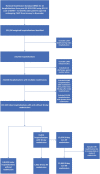Trends, Predictors, and Outcomes of 30-Day Readmission With Heart Failure After Transcatheter Aortic Valve Replacement: Insights From the US Nationwide Readmission Database
- PMID: 35929464
- PMCID: PMC9496292
- DOI: 10.1161/JAHA.121.024890
Trends, Predictors, and Outcomes of 30-Day Readmission With Heart Failure After Transcatheter Aortic Valve Replacement: Insights From the US Nationwide Readmission Database
Abstract
BACKGROUND Data on trends, predictors, and outcomes of heart failure (HF) readmissions after transcatheter aortic valve replacement (TAVR) remain limited. Moreover, the relationship between hospital TAVR discharge volume and HF readmission outcomes has not been established. METHODS AND RESULTS The Nationwide Readmission Database was used to identify 30-day readmissions for HF after TAVR from October 1, 2015, to November 30, 2018, using International Classification of Diseases, Tenth Revision, Clinical Modification (ICD-10-CM) codes. A total of 167 345 weighted discharges following TAVR were identified. The all-cause readmission rate within 30 days of discharge was 11.4% (19 016). Of all the causes of 30-day rehospitalizations, HF comprised 31.4% (5962) of all causes. The 30-day readmission rate for HF did not show a significant decline during the study period (Ptrend=0.06); however, all-cause readmission rates decreased significantly (Ptrend=0.03). HF readmissions were comparable between high- and low-volume TAVR centers. Charlson Comorbidity Index >8, length of stay >4 days during the index hospitalization, chronic obstructive pulmonary disease, atrial fibrillation, chronic HF, preexisting pacemaker, complete heart block during index hospitalization, paravalvular regurgitation, chronic kidney disease, and end-stage renal disease were independent predictors of 30-day HF readmission after TAVR. HF readmissions were associated with higher mortality rates when compared with non-HF readmissions (4.9% versus 3.3%; P<0.01). Each HF readmission within 30 days was associated with an average increased cost of $13 000 more than for each non-HF readmission. CONCLUSIONS During the study period from 2015 to 2018, 30-day HF readmissions after TAVR remained steady despite all-cause readmissions decreasing significantly. All-cause readmission mortality and HF readmission mortality also showed a nonsignificant downtrend. HF readmissions were comparable across low-, medium-, and high-volume TAVR centers. HF readmission was associated with increased mortality and resource use attributed to the increased costs of care compared with non-HF readmission. Further studies are needed to identify strategies to decrease the burden of HF readmissions and related mortality after TAVR.
Keywords: TAVI; TAVR; heart failure; transcatheter aortic valve implantation; transcatheter aortic valve replacement.
Figures



Similar articles
-
Determinants and Impact of Heart Failure Readmission Following Transcatheter Aortic Valve Replacement.Circ Cardiovasc Interv. 2020 Jul;13(7):e008959. doi: 10.1161/CIRCINTERVENTIONS.120.008959. Circ Cardiovasc Interv. 2020. PMID: 32600108
-
Thirty-Day Readmissions After Transcatheter Aortic Valve Replacement in the United States: Insights From the Nationwide Readmissions Database.Circ Cardiovasc Interv. 2017 Jan;10(1):e004472. doi: 10.1161/CIRCINTERVENTIONS.116.004472. Circ Cardiovasc Interv. 2017. PMID: 28034845
-
Development and Validation of a Machine Learning Risk-Prediction Model for 30-Day Readmission for Heart Failure Following Transcatheter Aortic Valve Replacement (TAVR-HF Score).Curr Probl Cardiol. 2024 Feb;49(2):102143. doi: 10.1016/j.cpcardiol.2023.102143. Epub 2023 Oct 18. Curr Probl Cardiol. 2024. PMID: 37863456
-
Thirty-Day Readmission Rate and Healthcare Economic Effects of Patients With Transcatheter Aortic Valve Replacement and Coexisting Chronic Congestive Heart Failure.Curr Probl Cardiol. 2023 Jul;48(7):101695. doi: 10.1016/j.cpcardiol.2023.101695. Epub 2023 Mar 14. Curr Probl Cardiol. 2023. PMID: 36921650 Review.
-
Identifying patients likely to be readmitted after transcatheter aortic valve replacement.Heart. 2020 Feb;106(4):256-260. doi: 10.1136/heartjnl-2019-315381. Epub 2019 Oct 24. Heart. 2020. PMID: 31649048 Review.
Cited by
-
Impact of Baseline Anemia in Patients Undergoing Transcatheter Aortic Valve Replacement: A Prognostic Systematic Review and Meta-Analysis.J Clin Med. 2023 Sep 18;12(18):6025. doi: 10.3390/jcm12186025. J Clin Med. 2023. PMID: 37762965 Free PMC article. Review.
-
Emergency department imaging utilization post-transcatheter aortic valve replacement: single institution 7-year experience.Emerg Radiol. 2024 Jun;31(3):349-357. doi: 10.1007/s10140-024-02228-y. Epub 2024 Apr 23. Emerg Radiol. 2024. PMID: 38649665 Free PMC article.
-
Enhancing Frailty Assessments for Transcatheter Aortic Valve Replacement Patients Using Structured and Unstructured Data: Real-World Evidence Study.JMIR Aging. 2024 Nov 27;7:e58980. doi: 10.2196/58980. JMIR Aging. 2024. PMID: 39602825 Free PMC article.
-
Readmissions After Left Atrial Appendage Closure in Patients With Previous Ischemic Stroke or Transient Ischemic Attack.CJC Open. 2023 Sep 17;5(12):950-964. doi: 10.1016/j.cjco.2023.09.009. eCollection 2023 Dec. CJC Open. 2023. PMID: 38204857 Free PMC article.
-
Readmission Mortality After TAVR: The Combined Effect of Teaching Hospital Status and Cause of Readmission.CJC Open. 2025 Jan 27;7(4):481-488. doi: 10.1016/j.cjco.2024.12.014. eCollection 2025 Apr. CJC Open. 2025. PMID: 40433130 Free PMC article.
References
-
- Sanchez CE, Hermiller JBJ, Pinto DS, Chetcuti SJ, Arshi A, Forrest JK, Huang J, Yakubov SJ. Predictors and risk calculator of early unplanned hospital readmission following contemporary self‐expanding transcatheter aortic valve replacement from the STS/ACC TVT registry. Cardiovasc Revasc Med. 2020;21:263–270. doi: 10.1016/j.carrev.2019.05.032 - DOI - PubMed
MeSH terms
LinkOut - more resources
Full Text Sources
Medical
Research Materials
Miscellaneous

